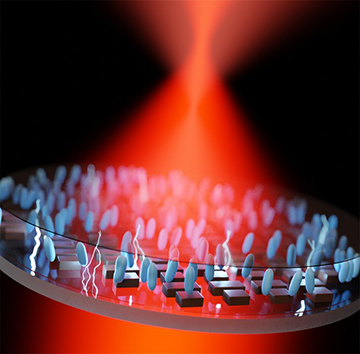
A conceptual rendering of an ultrathin lens, developed by Cornell and Samsung engineers, that combines a metasurface with liquid-crystal arrays to allow the focal length to be electrically tuned. [Image: Daniil Shilkin]
Researchers have created an ultrathin lens that uses liquid crystals and adjustable voltage to allow continuous zoom and refocusing, without mechanical parts (Nano Lett., doi: 10.1021/acs.nanolett.1c00356). The team says that the lens offers an alternative to traditional bulky mechanical systems and could be implemented wherever space and weight are limited.
For starters, the researchers hope to use the new lenses for augmented-reality (AR) glasses. “But the potential scope of applicability goes way beyond” AR devices, according to Maxim Shcherbakov, a postdoctoral researcher at Cornell University, USA, and coauthor on the study. “The lens can be a foundation for any sort of optical system that requires ultrathin lenses, from aerial images to microscopes and other optical systems.”
Metalenses reimagined
The new device is part of a growing class of so-called metalenses—lenses less than a micron thick created from metasurfaces. These engineered surfaces have previously enabled unique optical properties in designs from flat optics to polarizers to holograms, but previous metalenses had fixed focal lengths. In the newly published work, the design combines liquid-crystal arrays with metalenses to create a system with multiple focal points.
The millimeter-scale lens, designed by researchers at Cornell and Samsung’s Advanced Institute of Technology, uses tiny silicon-based nanoparticles in a liquid-crystal cell. When a voltage is applied to electrodes sandwiching the cell, it causes the liquid-crystal molecules to align in a certain direction. The alignment affects the resonances of the nanoparticles, which changes the focus of the lens.
By varying the voltage, the liquid-crystal molecules can be arranged at a range of angles, which creates a range of focal distances. When used in a zoom system, the new lens can provide continuous zoom with focusing up to 20% of the distance from a target focal distance.
Against the odds
Researchers have previously tried to merge metalenses with liquid-crystal arrays, but the team behind the new work says its study is the first successful proof-of-concept.
“The success story here is that we’ve implemented a very convoluted design process where we analyzed ten thousand different nanoparticle candidates,” Shcherbakov said. After finding candidates that the numerical calculations suggested would work well, the researchers tested them in a metalens. “When we fabricated the sample, it worked like a charm.”
The proof-of-concept design, however, still has some hurdles to clear for widespread use. The lens only works at a specific red wavelength and with a specific polarization of light. But the researchers are already working on multiwavelength and polarization-independent versions, as well as extending the focal distance by a factor of two and scaling up to lenses 5 to 10 mm in size.
